2. Synthetic means of form-building.
3. Analytical forms.
1. The main task of morphology
is the study of the structure of words. The sinallesl significant
(meaningful) units of grammar are called morghemes.
Morphemes are commonly
classified into free (those which can occur as separate words) and
bound. A word consisting of a single (free) morpheme is
monomorphemic, its opposite is polymorphemic.
According to their meaning
and, function morphemfes are subdivided into lexical (roots),
lexico-grammatical (word-building affixes ) and grammatical
(form-building affexes, or inflexions)
Morphemes
are abstract units, respresented in speech by morphs. Most morphemes
are realized by single morphs: un-self-ish.
Some morphemes may be manifested by more than one morph according to
their position. Such alternative morphs, or positional variants of a
morpheme are called allomorphs: cats, [s], dog’s [z], foxes [iz],
oxen.
Morphemic variants are
identified in the text on the basis of their co-occurence with other
morphs, or their environment. The total of environments constitutes
the distribution.
There may
be three types of morphemic distribution: contrastive,
non-contrastiye, conplementary Morphs are in coutrastive distribution
if their position is the same and their meanings are different:
charming
— charmed.
Morphs are in non-contrastive distribution if their position is the
same and their meanings are the same: learned
— learnt.
Such morphs constitute free variants of the same morpheme. Morphs are
in complementary distribution if their positions are different and
their meanings are the same: speaks.
-teaches.
Such morphs are allomorphs of the same morpheme.
Grammatical
meanings may be expressed by the absence of the morpheme. Compare:
book
— books.
The meaning of plurality is expressed by the morpheme —s.
The meaning of singularity is expressed by the absence of the
morpheme. Such meaningful absence of the morpheme is called
zero-morpheme.
The
function of the morpheme may be performed by a separate word. In the
opposition work
— will work
the meaning of the future is expressed by the word will.
Will is a contradictory unit. Formally it is a word, functionally it
is a morpheme. As it has the features of a word and a morpheme, it is
called a word morpheme. Word-morphemes may be called semi-bound
morphemes.
2. Means of form-building and
grammatical forms are divided into synthetic and analytical.
Synthetic forms are built with
the help of bound morphemes, analytical forms are built with the help
of semi-bound morphemes (word-morphemes).
Synthetic means of
form-building are affixation, sound-interchange (inner-inflexion),
suppletivity.
Typical
features of English affixation are scarcity and homonymy of affixes.
Another characteristic feature is a great number of zero-morphemes.
Though .English grammatical
affixes are few in number, affixation is a productive means of
form-building.
Sound
interchange may be of two types: vowel- and consonant-interchange. It
is often accompanied by affixation: bring
— brought.
Sound interchange is not
productive in Modern English. It is used to build the forms of
irregular verbs.
Forms of
one word may be derived from different roots: go
— went, I— me, good — better.
This means of form-building is called suppletivity. Different roots
may be treated as suppletive forms if:
1) they have the same lexical
meaning;
2) there are no parallel
non-suppletive forms;
3) other words of the same
class build their forms without suppletivity.
Suppletivity, like
inner-inflexion, is not productive in Modern English, but it occurs
in words with a very high frequency.
3.
Analytical forms are combinations of the auxiliary element (a word
-morpheme) and the notional element; is
writing.
Analytical forms are
contradictory units: phrases in form and wordforms in function.
In the
analytical form is
writing
the auxiliary verb be
is lexically empty. It expresses the grammatical meaning. The
notional element expresses both the lexical and the grammatical
meaning. So the grammatical meaning is expressed by the two
components of the analytical form: the auxiliary verb be
and the affix —ing..
The word-morpheme be
and the inflexion —ing
constitute
a discontinuous morpheme.
Analytical forms are
correlated with synthetic forms. There must be at least one synthetic
form in the paradigm.
Analytical forms have
developed from free phrases and there are structures which take an
intermediary position between free phrases and analytical forms: will
go, more beautiful.
The abundant use of analytical
forms, especially in the system of the verb, is the characteristic
feature of Modern English.
TOPIC IV
Parts
of Speech
Соседние файлы в предмете [НЕСОРТИРОВАННОЕ]
- #
- #
- #
- #
- #
- #
- #
- #
- #
- #
- #
3. The allo-emic principle.
4. The types of morphemes.
5. Types of word-form derivation.
1. Grammar has two constituent parts: Morphology & Syntax.
Morphology deals with morphological units (the morpheme & the word); word-forms, which signify some general conceptual notions (grammar. meanings, grammatical forms, grammatical categories). It also studies the parts of speech. Morphology has certain branches: one of them is morpho-phonemics, which describes the phonological representation of meaningful morphemes.
E.g.: morphophonemic vowel interchange in «ring — rang — rung» plays a definite part in the system of form-building. The vowel interchange in the words «food -feed is a means of word-building.
Another branch of Morphology — morphemics deals with the description of the morphological models of the language. In other words, it describes the morpheme structure, the ways of their location in the units of high level. E.g.: 2. Even casual comparison of such word form as dogs, boys, with the
corresponding dog, boy, will show that the 1st set may be split into 2 grammatically significant elements (+), which, on the one hand, convey the meaning, and on the other, cause the certain agreement between the words in a sentence. Thus, we say: «The dog sleeps in a kennel», but «The dogs sleep in a kennel. The form «dog» can’t be divided into future grammatically significant elements. Further division may be only phonologically. The described minimal grammatical units are called morphemes. They are delimited by comparing word form with one another and by singling out the recurrent pieces that compose them. A word may consist of 1 or more morphemes, each morpheme them conveys a particular lexical or grammatical meaning.
The morpheme — is the smallest meaningful, further indivisible recurrent component of a word or a word form.
3. If the approach from the point of view of speech, we can observe the following phenomenon: the morphemes like words may exhibit different forms in the process of speaking. It depends on their position within the word. E.g.: the regular formative of the plural number morpheme «s» may be represented in speech in different ways.
In languageIn speech
[s] — book
— (e)s[z] — boys
[iz] — boxes
Allomorphs are speech variants of morphemes.
At the basis of allo-emic elements lies the division into language and speech. The term morphemes stands for the whole grammatically relevant class of forms. They belong to language. It is an abstract entity which expresses particular grammatical meaning. Em-terms denote generalized invariants of language, characterized by a certain functional status ( Allo-morphes denote the concrete manifestation of invariants, of the generalized units, dependent on the regular colligation with other elements of the language.Invariants are abstract. The allo-morphs (or variant morphemes ) like [s], [z], [iz] are phonologically predictable, but we have many examples of allo-morphs , which can’t be explained by usage of speech criteria. Thus, the English plural form of the word «ox» — «oxen» is grammatically parallel to «dogs». «En» is an
irregular form of the plural number. There are other irregular forms: «children», «geese». Professor Robins considered them to be allo-morphs of the plural number morphemes. According to the tradition, which goes back to Panini Grammar, such specific forms as……… are considered by linguists as having any form (0 form ) of plural number.
There is another group of words which have a specific morphemic structure: E.g.:»man — men», «tooth — teeth». The plural forming morpheme is represented not by any recurrent formative like [s], but a process of root vowel interchange. E.g.: [ж] — [e] etc. We are dealing here with infix morphemes. Such word forms are rarely survivals of the specific morphemic structure of Old English. To simplify the complicated
system of analysis, professor Ilysh V.A. and others refer all the speech exhibits of the plural number morphemes to the allo-morphs of the plural number morphemes, which graphically may be depicted as following: Language Speech plural number morphemes [s], [z], [iz], [ш], [ж]—[e], [f]—[vz],[u]—[i]. The analysis and classification of different phonological forms in which morphemes appear, both in individual languages and in languages in general is called Morphonology, which is the same as morphophonemics. When discussing the different forms of the English plural number morphemes we applied the morphophonological analysis.
4. There are two criteria in classifying morphemes:
1). Positional
2). Functinal (semantic).
According to positional criterion morphemes are divided into: root morphemes and affixal morphemes (affixes,{prefixes, infixes, suffixes}). In other words, root morphemes are called free morphemes, while affixal are bound morphemes. A free morpheme is vand ?. a bound morpheme is one, that must appear with at least one other morpheme, bound or free. E.g.: «work»+»ed». Root morphemes are unlimited in number. Affixes are bound morphemes, they are limited in number, and may be exhaustedly elisted. Some words have more than one morpheme, they are compound words. E.g.: » bird-cherry «, «scare-crow». In English the majority of roots are free. But nevertheless there are bound root morphemes. They are the following.
E.g.: receive, conceive
retain, contain
transfer, refer.
Affix is a term denoting recurrent formative morphemes, other than roots. From the point of view of formal presentation we distinguish: overt [ouvit] and covert [kA vit]. Overt morphemes are represented explicitly: «retell», «asked»; covert morphemes coincide with 0(zero morpheme). Every morpheme is the smallest meaningful unit, thus «ed» conveys the morpheme of Past tense. We should differentiate form-building morphemes (that are grammatical) and word-building
morphemes (they are lexical). E.g.: movement , outline — word-building morphemes asked, asks, getting — form-building morphemes 5. Form-building morpheme is called word changing. Modern English extremely poor according to the word-changing, but there are some.
1). Affixation.
It is the use of epithets. E.g.: «bus» — «buses».
Only Suffixation is used in modern English. Prefixation was productive in old English period. For the formation of perfect participle
2). Sound Interchange.
Vowel interchange Consonant interchange
3). Supplative forms
«bad» — «worse» — «worst»
«go» — «went» — «gone»
«be», «is», «are», «am» — «was», «were» — «been».
All of 1), 2), 3) — belong to the syntactic way of form-building.
4). Analytical forms are particular word-combinations, made up of an auxiliary or a notional word.
LECTURE 4.
Analytical forms are very productive in modern English
Grammar deals with form-building .
is……………………………………………..ing
have…………………………………………en frames
was…………………………………………..ed
continuous morphemes
The matter is, that the analytical ???????? (can be put) consist of two meaningful morphemes. Analytical morphemes are not free word combination like «a red rose», neither are phraseological units like » red tape»(burocracy). Analytical forms can’t be compared with words, they are word forms like synthetic forms, performing a definite grammatical function. The word
1. The definition of the word.
2. The characteristic features of the word.
3. The two planes of the word.
The word is the main object of lexicology as well. It is not easy to give rigorous definition of the word. Since it is very complex and many sided phenomenon. The term «word» denotes the basic unit of a given language, resulting from the associations of a particular meaning with the particular group of sounds, capable of the particular grammatical employment. Arnold, «The
English word». This working definition of the word implies that the word is simultaneously
a semantical and grammatical unit. There are many definitions of the word and none of them are generally accepted. The word is considered to be the minimal potential sentence, the minimal free linguistic form, the elementary component of the sentence, the sound symbol, the meaningfully integral and immediately identifiable unit.
The difficulty in defining the word compel some linguists to exclude the word from the basic unit of the language. L. Bloomfield school in US. That school linguists consider the morpheme and the phoneme to be the basic units of linguistic description, for the phoneme can be easily isolated from the context thanks to its minimal elementary segmental character. They consider the phoneme to be the minimal formal segment of language and the morpheme to be the ultimate
meaningful segment. The main drawback of descriptive linguistics is that they approach the definition of the linguistic units on a formal basis. The other linguists came to the conclusion, that such units must be defined by taking into consideration their formal and functional (semantic) features.
2. In actual speech people experience no difficulty in separating one word from another. Traditionally, linguists point out isolatebility as the most characteristic features of the word. One word can form a sentence («Fire!», «Thanks!»,…). Another characteristic feature of the word is its
uninterruptibility or indivisibility. Even if you take compound words, such as «blackberry», «blue-eyed», you won’t be able to insert another word in the middle of this compound word. Third feature is a certain looseness in the sentence, i.e. that you may place the word in different parts of the sentence. E.g.: «The bat flew down.»=»Down flew the bat.»But still, don’t forget, that the English word-order is rigid unlike the Russian word order. Russian language is a highly developed morphological system. The set looseness is marked in writing by the graphic form of the word with certain spaces between the words.
In oral speech, every word is separated from its neighbours by one unit pause. Some difficulty is paused by the application of the term «word». Some linguists regard such group of words as work, worked, is working as one word. The whole group can’t be used as a unit of speech, for the unit must belong both to language & speech. Of all the group, only the element «work» can be regarded as an objective unit of the language. All the grammeme are called lexeme. «A lexeme is a group of word forms, united by the common lexical meaning, but having different grammatical meaning.»
If we take a group of words, united by the common grammatical meaning, we shall get a grammeme.
E.g.: sleeps, reads, tries, fucks — Grammeme.
A number of elements of the lexeme may vary from 1 («must») to many.
E.g.: The lexeme, represented by the word «wright» Þ contains Þ 94 elements, expressed by 64 forms.
The number of words in a grammeme is practically limitless. But the gammeme having the meaning only Past tense, indicative mood, plural number, not perfect, not continuos aspects, contains only 1 word : were .The word is a nominative ( naming ) unit of language .It enters the vocabulary as its elementary component indivisible into smaller segments.The word is used for the formation of the sentence. The word is the basic unit of the language , which occupies the key position in the language. It’s universal in its character. It is capable of performing any function in the language : nominative, significant, communicative & pragmatic. The functional sphere of the word is very wide. It may represent a morpheme ( free place ), a nominative sign ( desk ), A part of a word group ( a big fire ) & a sentence ( Fire! ).
3. A word is a linguistic sing. A linguistic sign is a bilateral entity, having it a content & formal side, which correlates with the concept & may indirectly reflect the objects & phenomena of objective reality ( extralinguistic reality ). Not all the linguistic signs have reference to the outer world. Being a bilateral linguistic sign, the word is characterized by 2 planes :
The plane of content
The plane of expression.
bombthe plan of expression
the plane of content
The first & the second are the dialectical unity of form and content. In the plane of expression, the word has its material representation. In oral speech it is represented acoustically by a group of sounds, in written speech — graphically. The plane of content includes the lexical meaning of word. The word exists in two dimensions, namely as a virtual polysemantic sign of the vocabulary, and as an actual sign, used in speech.
The virtual side of the language sign exists in the sphere of language. It is an unrealized word, while the actual side of the word belongs to the syntagmatic sphere of speech.
LECTURE N 5.
Theme : Grammatical categories.
Grammar abstracts itself from particular meanings of words and deals with the most generalized meanings, that may be proper to big groups of words with different lexical meanings.
In logic, the most general notions reflecting the most general properties of some phenomena are called categorial notions ( or categories ). The most general meanings in Linguistics are regularly expressed through the system of the paradigmatically organized word forms and are interpreted as categorial meanings.
According to the general methodological law, every content must have a certain material form of expression. If we take a generalized meaning of plurality we can find its material implementation in many word forms such as : streets, cars, houses, girls, students which make up a grammeme. The grammatical phenomena, like the word in lexicology are also characterized by the 2 planes : the plane of content ( meaning ) & the plane of form ( expression ).
Lecture 6 Word-structure and Word-formation
Plan: 1. 2. 3. 4. 5. Word-structure and morphemes. Morphemic types of words. Segmentation of words into morphemes. Types of word segmentability. Derivative structure. Derivational analysis. Major types of word-formation: affixation, conversion, word-composition. Secondary types of word-formation.
1. Word-structure and morphemes. Morphemic types of words
The Morpheme: the smallest ____ indivisible two-facet language unit.
Meaning of word building morphemes: 1. lexical meaning: — ______ (serves a linguistic expression for a concept or a name for an individual object) Especially revealed in root-morphemes. E. g. -girl- -ly, -like, -ish ; – similarity — ______ (an emotional content of the morpheme) E. g. the suffix in piglet has a diminutive meaning.
Word building morphemes do not possess grammatical meaning.
Meaning of word building morphemes: 2. part-of-speech meaning (is proper only to _______) (government, teach-er)
Specific meaning of word building morphemes: n Differential: serves to distinguish words having the same morphemes (over-cook, under cook, precook) n Distributional (the meaning of morpheme arrangement in a word: certain morphemes usually follow or precede the root) (un-effective, speech-less)
Semantic Classification of Morphemes: ______ morpheme (the lexical center of words, has an individual meaning) n non-root or ______ morpheme. n
Affixational Morphemes: 1. form building, or inflectional morphemes (only _____ meaning and only for the formation of word-forms) n smiled, smiles, is smiling
2. derivational morphemes (the smallest meaningful stem building or word building lexical units) n reason-able, un-reason-able
Derivational morphemes: n prefixes n suffixes
Structural classification: 1. ______ morphemes (may function independently. Most roots are free) n friend- in the word friendship 2. ______ morphemes (function only as a constituent part of a word). Affixes are bound morphemes.
3. semi-free (semi-bound) morphemes (can function both as an ______ and as a ______ morpheme). n • • the morpheme well: the stem and the word-form in the utterance like sleep well; a bound morpheme in the word wellknown.
According to the Number of the Morphemes: § monomorphic words § polymorphic
Monomorphic or root -words: only one rootmorpheme. § small, dog.
Polymorphic Words: 1) Monoradical (one-root words) monoradical suffixal (teacher); n monoradical prefixal (overteach); n radical prefixal-suffixal (superteacher, beheaded). n
2) Polyradical (consist of two or more roots): n polyradical proper (headmaster); n polyradical suffixal (head-teacher, boarding-school); n polyradical prefixal (superheadmaster); n polyradical prefixal-suffixal (superheadteacher).
2. Segmentation of words into morphemes. Types of word segmentability
According to the complexity of the morphemic structure: 1. segmentable words (allowing of segmentation into morphemes). n agreement, information, quickly. 2. non-segmentable words. n house, girl, woman.
Levels of the Analysis of the Word Structure: n Morphemic: its aim is to state the number and type of morphemes the word consists of. Basic units: ______ mislead — polymorphic, monoradical, radical-prefixal.
n Derivational: its aim is to establish the correlations between different types of words and to establish a word’s derivational structure. Basic units: derivational bases, derivational affixes, derivational patterns.
The Morphemic Analysis: the operation of breaking a segmentable word into the constituent morphemes.
The method of Immediate and Ultimate constituents (the IC and UC method): to know how many _____ parts are there in a word.
At every stage the word is broken into 2 components (IC-s) unless we achieve units incapable of further division – the so-called ultimate constituents.
Friendliness: 1. is divided into the component friendly-, occurring in such words as friendly, friendly-looking, and the component ness- as in dark-ness, happy-ness. 2. is divided into friend- and -ly which are ultimate constituents.
Types of Morphemic Segmentability of Words: 1. complete 2. conditional 3. defective
Complete Segmentability: one can easily divide a word into morphemes. The constituent morphemes of the word recur with the same meaning in a number of other words. n teacher: teach- — in to teach and teaching. -er – in words like worker, builder, etc.
Conditional Segmentability: when segmentation is doubtful for ____ reasons, as the segments (pseudo-morphemes) regularly occurring in other words can hardly possess any definite lexical meaning.
n retain, detain, contain or receive, conceive, perceive: sound-clusters [rı-], [dı-], [kən-] seem to be singled out quite easily due to their recurrence in a number of words, but they have nothing in common with the phonetically identical morphemes like re-, de- as in words rewrite, re-organize, decode.
Defective Segmentability: when segmentation is doubtful for ______ reasons because one of the components (a unique morpheme) has a specific lexical meaning but seldom or never occurs in other words.
n streamlet, ringlet, leaflet: the morpheme -let has the denotational meaning of diminutiveness and is combined with the morphemes stream-, ring-, leaf-, each having a clear denotational meaning. n hamlet – the morpheme -let retains the same meaning of diminutiveness, but the soundcluster [hæm] does not occur in any English word with the meaning it has in the word hamlet.
Morphological analysis: + reveals the number of meaningful constituents in a word and their usual sequence. — does not reveal the way the word is constructed.
3. Derivative structure. Derivational analysis
Words having the same morphological structure may be derived in completely different ways. n do-gooder: (do good) + -er (suffixation). n dress-maker: dress + (make + -er) (word -composition)
Derivatives: nare words depending on some other lexical items that motivate them structurally and semantically.
The basic elements of a derivative structure of a word: n a derivational base n a derivational affix n derivational pattern
A derivational base: n a unit to which derivational affixes are added. It is always monosemantic.
Derivational bases are built on the following language units: a) stems of various structure, b) word-forms (unknown: un + Ved –>A) c) word-groups or phrases (longlegged: (A + N) + ed –> A)
The derivational base a stem (an unchangeable part of the word throughout its paradigm) n unknown – derivational base n know – stem
A derivational affix is added to a derivational base.
They have lexical, functional, distributional, and differential meaning and are characterized by 2 functions: n stem-building (public, curious) n word-building (economic = economy + ic, courageous = courage + ous)
A derivational pattern: a scheme of order and arrangement of the IC-s of the word. n v + -er =N (teach-teacher, build- builder) n re + v = V (re + write — rewrite)
4. Major types of wordformation: affixation, conversion, wordcomposition
In English there are three major types of word-formation: affixation, n zero derivation (conversion), n composition (compounding). n
Affixation. Prefixation. Classifications of prefixes. Suffixation. Classifications of suffixes. Productivity of suffixes.
Affixation has been one of the most productive ways of word-building throughout the history of English.
Affixation: n formation of new words by adding _____ affixes to different types of derivational bases.
Affixes: n ______ (take part in deriving new words in the particular period of language development. To identify productive affixes one should look for them among neologisms). E. g. -er, -able. n ______. E. g. -hood, -ous.
The productivity of affixes their frequency of occurrence: there are some high-frequency affixes which are no longer used in word derivation (the adjective-forming suffixes -ful, -ly, etc. ).
Derived words formed by affixation may be the result of one or more applications of word-formation rule. Degrees of derivation: zero degree (found in simple words whose stem coincides with a word morpheme) (cat, table) n first degree (found in words with one derivational affix) (teach-er, re-write) n second degree (found in words formed by adding 2 derivational affixes in consequence) (teach-er head-teacher) n
Affixation: n suffixation n prefixation
Prefixation is the formation of words by means of adding a ______ to the stem. There about 51 prefixes in the system of Modern English word-formation.
The main function of prefixes: n to change the lexical meaning of the ______ part of speech. But the recent research showed that there about 25 prefixes which can transfer words to different parts of speech. to begulf, to debus, etc.
In Modern English suffixation is mostly characteristic of ______ and ______ formation, while prefixation is mostly typical of ______ formation.
The main function of suffixes: n to form one ______ from another (to work – a worker), n to change the ______ meaning of the ______ part of speech (to educate, educatee).
Main differences between suffixes and prefixes: suffixes functional meaning is significant prefixes functional meaning is not that important the same prefix may function in different parts of speech the main function of prefixes is to change the lexical meaning of the same part of speech usually function in one part of speech the main function of suffixes in Modern English is to form one part of speech from another (to work – a worker), the secondary function is to change the lexical meaning of the same part of speech (to educate, educatee) a characteristic of noun and typical of verb formation adjective formation
Prefixes may be classified on different principles: 1) origin of prefixes: native (Germanic) (un-, over-, under-, etc. ); n Romanic (in-, de-, re-, ex-, etc. ); n Greek (sym- sympathy, hyper- hypertension, etc. ). n 2) the lexico-grammatical type of the stem: deverbal (overdo, rewrite); n denominal (unbutton, ex-president); n deadjectival (uneasy). n
Prefixes may be classified on different principles: 3) meaning: negation (ungrateful, incorrect, disadvantage, etc. ); n time and order (foretell, foreknowledge, pre-war, post-war, etc. ); n repetition (rebuild, re-write, etc. ); n location (subway, inter-continental, etc. ), n quantity and intensity (bilingual, polytechnical), etc. n 4) stylistic reference: neutral stylistic reference (over-, re-, under-, etc. ); n with stylistic value (super-, ultra-, pseudo-, bi-, etc. ). n
Disputable cases: n words with a disputable structure, such as contain, retain, detain and conceive, receive, deceive, where we can see that re-, de-, con- act as prefixes and -tain, -ceive can be understood as roots. But in English these combinations of sounds have no lexical meaning and are called pseudo-morphemes. Some scientists treat such words as simple words, others as derived ones.
Suffixes may be classified according to: 1) the part of speech formed: a) noun-forming suffixes (-er, -dom, -ation, etc. ) (teacher, Londoner, freedom, justification, etc. ); b) adjective-forming suffixes (-able, -less, -ful, -ic, -ous, etc. ) (agreeable, careless, doubtful, poetic, courageous, etc. ); c) verb-forming suffixes (-en, -fy, -ize) (darken, satisfy, harmonize, etc. ); d) adverb-forming suffixes (-ly, -ward) (quickly, eastward, etc. ); e) numeral-forming suffixes (-teen, -ty ) (sixteen, seventy).
Suffixes may be classified according to: 2) lexico-grammatical character of the base the affix is usually added to: n deverbal (those added to the verbal base), e. g. -er, -ing, -ment, -able, etc. (speaker, reading, agreement, suitable, etc. ); n denominal (those added to the noun base), e. g. less, -ish, -ful, -ist, -some, etc. (handless, childish, mouthful, violinist, troublesome, etc. ); n deadjectival (those affixed to the adjective base), e. g. -en, -ly, -ish, -ness, etc. (blacken, slowly, reddish, brightness, etc. ).
Suffixes may be classified according to: 3) meaning. For instance, noun-suffixes fall into those denoting: a) the agent of an action, e. g. -er, -ant (baker, dancer, defendant, etc. ); b) nationality, e. g. -an, -ian, -ese, etc. (Arabian, Elizabethan, Russian, Chinese, etc. ); c) collectivity, e. g. -dom, -ry, -ship, etc. (moviedom, readership, peasantry, etc. ); d) diminutiveness, e. g. -ie, -let, -ling, etc. (birdie, piglet, wolfling, etc. ) e) quality, e. g. -ness, -ity (helplessness, answerability).
Suffixes may be classified according to: 4) the origin of suffixes: a) native (Germanic), such as -er, -ful, less, -ly; b) Romanic, such as : -tion, -ment, -able, eer; c) Greek, such as : -ist, -ism, -ize; d) Russian, such as -nik.
Suffixes may be classified according to: 5) productivity: a) productive, such as -er, -ize, -ly, ness; b) semi-productive, such as -eer, ette, -ward; c) non-productive, such as -ard (drunkard), -th (length).
Disputable cases: whether we have a suffix or a root morpheme in the structure of a word. In such cases we call such morphemes semi-suffixes, and words with such suffixes can be classified either as derived words or as compound words, e. g. -burger (cheeseburger), -aholic (workaholic).
Conversion. Typical semantic relations. Productivity of conversion.
The term conversion was first mentioned by H. _______ in 1891.
Conversion: n a morphological way of forming words when one part of speech is formed from another part of speech by changing its ______ The morphological paradigms of the word eye n as a noun: eye — eyes n as a verb: to eye, eyes, eyed, will eye
The clearest cases of conversion are observed between verbs and nouns, and this term is now mostly used in this narrow sense.
Conversion is very active both in nouns for verb formation: doctor to doctor, shop to shop in verbs to form nouns: to smile a smite, to offer an offer).
Typical semantic relations (verbs converted from nouns): a) names of _______ of a human body and _______ , _______ – verbs have instrumental meaning (to hammer, to rifle, to nail), b) verbs denote an action characteristic of the _______ denoted by the noun from which they have been converted (to crowd, to wolf, to ape),
Typical semantic relations (verbs converted from nouns): c) verbs denote acquisition, addition or deprivation if they are formed from nouns denoting an object (to fish, to dust, to paper), d) the name of a _______ – verbs denote the process of occupying the place or of putting smth. /smb. in it (to room, to house, to cage), e) the _______ denoted by the noun – verbs denote an action performed at the time (to winter, to week-end),
Typical semantic relations (verbs converted from nouns): f) the name of a _______ or occupation – verbs denote an activity typical of it (to nurse, to cook, to maid, to groom), g) the name of a _______ – verbs denote the act of putting smth. within the container (to can, to bottle, to pocket). h) the name of a _______ – verbs denote the process of taking it (to lunch, to supper).
Nouns converted from verbs can denote: a) instant of an action, e. g. a jump, a move, b) process or state, e. g. sleep, walk, c) agent of the action expressed by the verb from which the noun has been converted, e. g. a help, a flirt, a scold,
Nouns converted from verbs can denote: d) object or result of the action expressed by the verb from which the noun has been converted, e. g. a burn, a find, a purchase, e) place of the action, e. g. a drive, a stop, a walk.
The main reason that conversion pairs are so widely spread in present-day English: a limited number of inflexions the word-formation based on changing the paradigm is very economical and productive.
Word-composition. Features of compoundwords. Classifications of compound-words.
Composition nthe way of word building when a word is formed by joining two or more _______ to form one word.
As English compounds consist of free forms, it is difficult to distinguish them from phrases.
Criteria of distinguishing compound words: 1) _______ (solid or hyphenated spelling), e. g. phrase-book, Sunday. 2) _______ (based on the position of stress). There is a tendency to put heavy stress on the 1 -st element (‘blackboard, ‘ice-cream). But this rule does not hold in some cases: with adjectives (new-‘born, easy-‘going) etc.
3) _______ (a compound is a combination forming a unit that expresses a single idea and that is not identical in meaning to the sum of the meanings of its components in a free phrase). 4) the unity of _____ and _____ functioning. Compounds are used in a sentence as one part of it and only one component changes grammatically, e. g. These girls are chatterboxes. «Chatter-boxes» is a predicative in the sentence and only the second component changes grammatically.
Borderline cases (present the greatest difficulty in determining their status as compounds): n String compounds (sit-on-the-fenceattitude, once-in-a-time-opportunity). n «Stone Wall» constructions. n Bound stems/semi-affixes (seaman, homophobia).
Characteristic features of English compounds: n Both components in an English compound are free stems: they can be used as words with a distinctive meaning of their own. n English compounds have a two-stem pattern, with the exception of compound words which have form-word stems in their structure, e. g. middle-of-the-road, off-therecord, up-and-doing etc.
Compounds may be classified according to: 1. The way components are joined together: a) _______ (by joining together two stems without any joining morpheme), e. g. ball-point, to windowshop, b) _______ (components are joined by a linking element: vowels «o» or «i» or the consonant «s» ), e. g. handicraft, sportsman, c) _______ (components are joined by means of form-word stems), e. g. here-and-now, free-for-all.
Compounds may be classified according to: 2. Their _____: n compound proper (formed by joining two stems), e. g. to job-hunt, train-sick, n compound-derived compounds (besides the stems they have affixes), e. g. ear-minded, hydro-skimmer, n compound-shortened words, e. g. Eurodollar, H-bomb.
Compounds may be classified according to: 3. Semantic relations: 1) _______ (the meaning of the whole is the sum total of the meanings of the components), e. g. music-lover, flower-bed 2) _______ , e. g. hotdog, wet-blanket
5. Secondary types of word-formation
_____ types of wordformation: n lexicalization, n sound-imitation, n reduplication, n back-formation, n sound and stress interchange, n shortening (abbreviation, acronymy, blends, clipping).
Besides major types of word-formation (affixation, composition and conversion) in English, there are some other types, which are less important for replenishment of vocabulary. Some of them (sound-interchange, stress shift and back-formation) were acting in the past and are more important for diachronic research of vocabulary. Such types as clipping, blending, and acronymy are very common in modern English.
Lexicalization: the process, when due to some semantic and syntactic reasons, the grammatical flexion in some word forms loses its _____ meaning and becomes isolated from the paradigm e. g. the plural of nouns like arms, colours of the words arm and colours. As the result these word forms (arms, colours) develop a different lexical meaning (arms = weapons and colours = flag) and become independent words. n
Sound-imitation: n the way of word-building when a word is formed by _______ different sounds. E. g. to whisper, to sneeze, to whistle, to buzz, to bark, to bubble.
Reduplication: n the way of word-formation within which new words are formed by _____ a stem, either without any phonetic changes or with a variation of the root-vowel or consonant. E. g. bye-bye, gee- gee, hush-hush, ping-pong, dilly-dally.
Back-formation: n the creation of new words by losing a _______ morpheme (babysitter to baby-sit, editor to edit, beggar to beg). It is opposite to suffixation, that is why it is called back-formation.
Sound-interchange n the creation of new words by changing the _____ (to breathe – breath, food – feed)
Stress-shift: n the process of forming new words by replacement of _______ from one syllable to another (‘import – to im’port, ‘record – to re’cord).
Types of Shortening: n substantivisation n acronyms and letter abbreviations n blends (сращения) n clippings (усечения)
Substantivisation: n is dropping of the final nominal member of a frequently used attributive word-group. The remaining adjective takes on the meaning and all syntactic functions of the noun and, in this way, develops into a new word. A number of nouns in English appeared in this way (documentary – a doc. film; finals – final examination; an editorial – an editorial article).
Abbreviation: na _____ form of a _____ word or a phrase used in a text in place of the whole for economy of space and effort.
Main types of shortenings: n _______ abbreviations (the result of shortening of words and word-groups only in written speech while orally the corresponding full forms are used. They are used for the economy of space and effort in writing), e. g. Mon — Monday, April, Mr. , Dr. n _______ abbreviations
Acronyms and letter abbreviations: Though the border-line between them is rather vague scholars make distinction between these 2 notions.
Letter abbreviations: n are mere replacements of longer phrases including names of well-known organizations, agencies, institutions, political parties, official offices. They are pronounced ______ and, as a rule, possess no linguistic forms proper to words (ITV = Independent Television; SST = Supersonic Transport)
Acronyms n are regular vocabulary units spoken as _______ (CLASS, yuppie). All acronyms, unlike letter abbreviations, perform the syntactic functions of ordinary words and can have grammatical inflexions. n Eg. : MP-MP’s-MPs
Acronyms may be formed in different ways: n from the initial letters or syllables of a phrase (NATO = North Atlantic Treaty Organization; UNO = United Nations Organization) n from the initial syllables of each word of a phrase (Interpol = international police)
Blends: n are words created when _______ and _______ segments of two words are joined together (smog = smoke + fog; brunch = breakfast + lunch).
Clipping: n is creation of new words by shortening a word of 2 or more _______ without changing its class membership (van = caravan, advantage (in tennis); dub = double; mike = microphone).
As a rule, lexical meanings of the clipped and the original word do not coincide. E. g. : Doc refers only to «sb. who practises medicine», while doctor denotes also «the higher degree given by a University, and a person who has received it» – Doctor of Philosophy, Doctor of Law).
Clippings fall into: n initial (van = advantage) n medial (specs = spectacles, maths = mathematics) n final (fan = fanatic)
Слайд 1Morphology as a Part of Grammar
Lecture 2
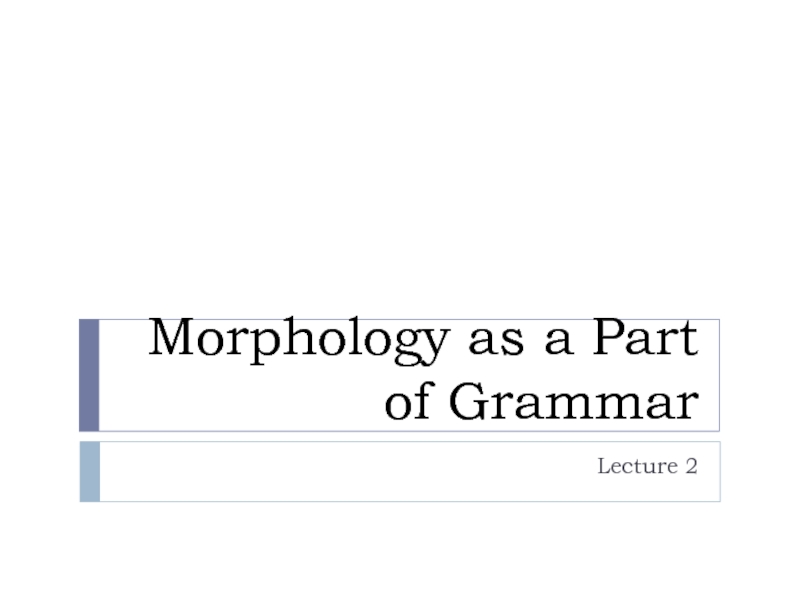
Слайд 2Traditional division of Grammar:
Morphology –
the grammar of words
Syntax —
the
grammar of sentences
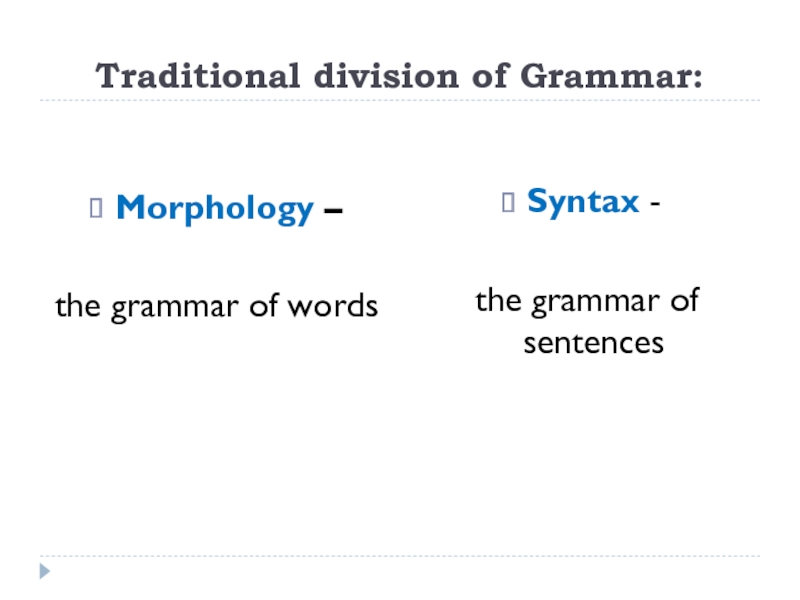
Слайд 3The grammatical structure of different languages depends on the type of
a language
In highly inflectional languages (Russian)
the syntactic role of the word in the sentence is manifested by the grammatical form of the word.
morphology plays an important role in the expression of grammatical meanings of words.
the word order is comparatively free.
In isolating languages (Chinese)
the syntactic role of a word is manifested by its position in the sentence.
the word order is fixed.
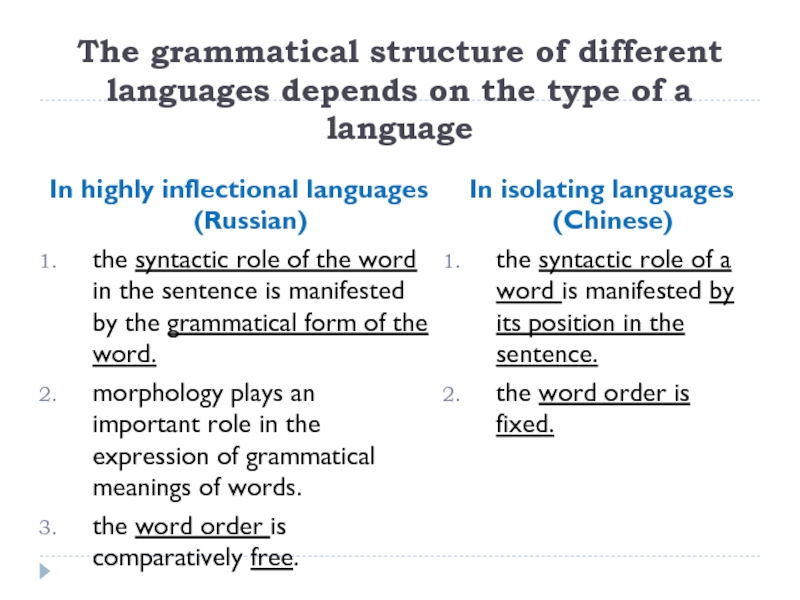
Слайд 4The division of Grammar
in modern linguistics
morphology – the part of
grammar which deals with word-forms (morphemes and words);
syntax – the part of grammar, which deals with combinations of words into word-groups and sentences;
text grammar – the part of grammar, which deals with the text macrostructure.
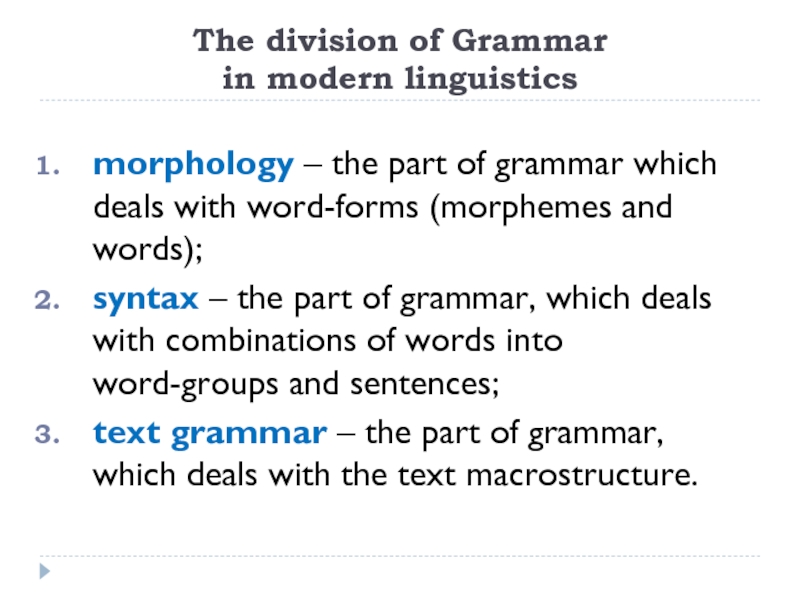
Слайд 5The line between morphology and syntax is not hard and fast
The
problem of tenses belongs to morphology or syntax?
The Form belongs to morphology and belongs to morphology since tenses have different forms: go –goes – went – shall / will.
The use of tenses seems to belong to syntax. In subordinate clauses the choice of tenses depends on the type of the clause:
You said you were American (object clause – sequence of tenses).
The girl who is smiling at us graduated from this college a year ago (attributive clause – free use of tenses).
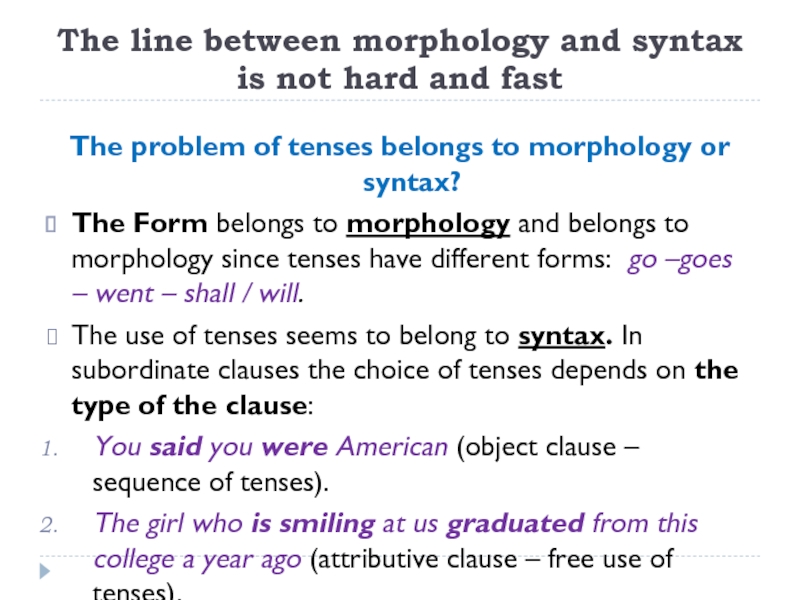
Слайд 6The classification of words into parts of speech seems to belong
to morphology…
In English we cannot be able to determine what part of speech a word is if it is not regarded within a word-group or a sentence:
Take a right turn! (noun) – Turn right (verb).
To be chicken (adjective) – to be a chicken (noun) –
to chicken (verb).
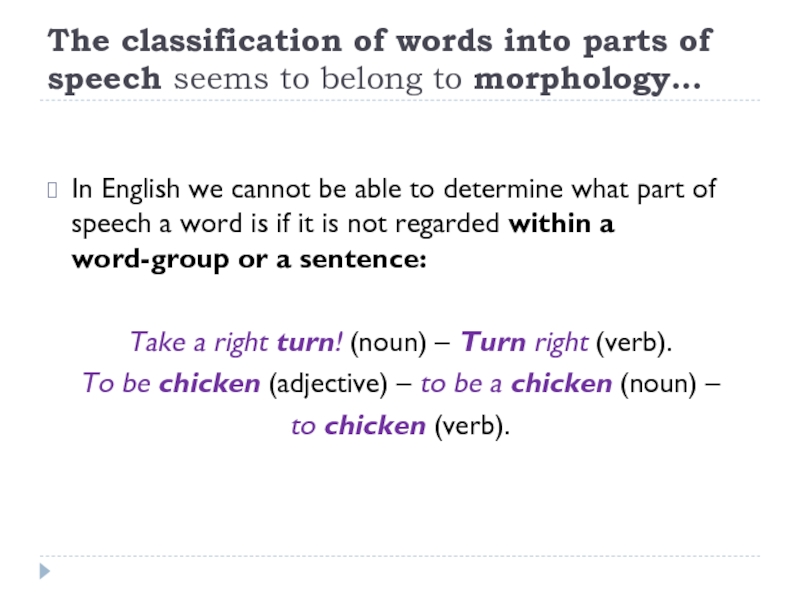
Слайд 7The 3rd part of grammar —
text grammar/ discourse analysis.
Text — a
unit larger than sentence.
The research — discovering and classifying types of text structures (composition forms, or macrostructure).
The analysis of the text macrostructure, a large-scale statement of the text’s content (meaning).
Basic units of the text grammar: superphrasal unities (sentence-groups) and texts.
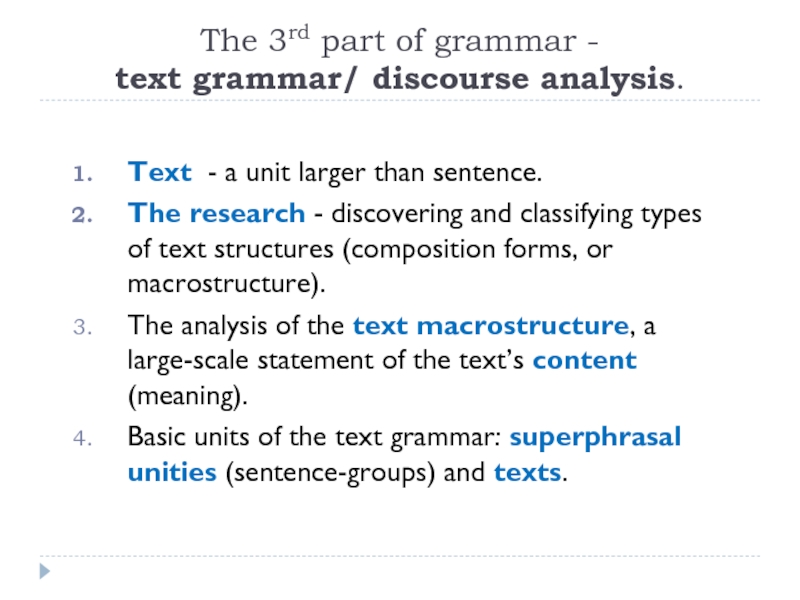
Слайд 8Discourse analysis – a method of analysis of connected speech for
correlating ’culture’ and language (Z. Harris)
Basic units of discourse analysis – texts in social contexts.
Discourses are everything that is connected with texts
(participants, their age, occupation, gender, race, education; the purpose of the text; social, cultural, personal meanings; actions performed by the participants, etc.).
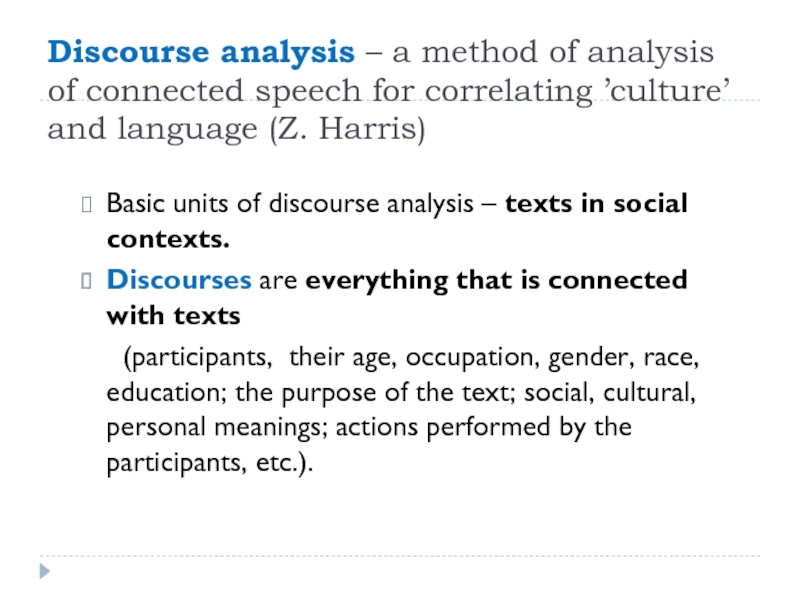
Слайд 9‘Text’ & ‘Discourse’ – aspects of the same phenomenon (communication)
Text –
a basic means of communication.
Discourse – the process of communication (text & social context) with emphasis on its functional (social) context.
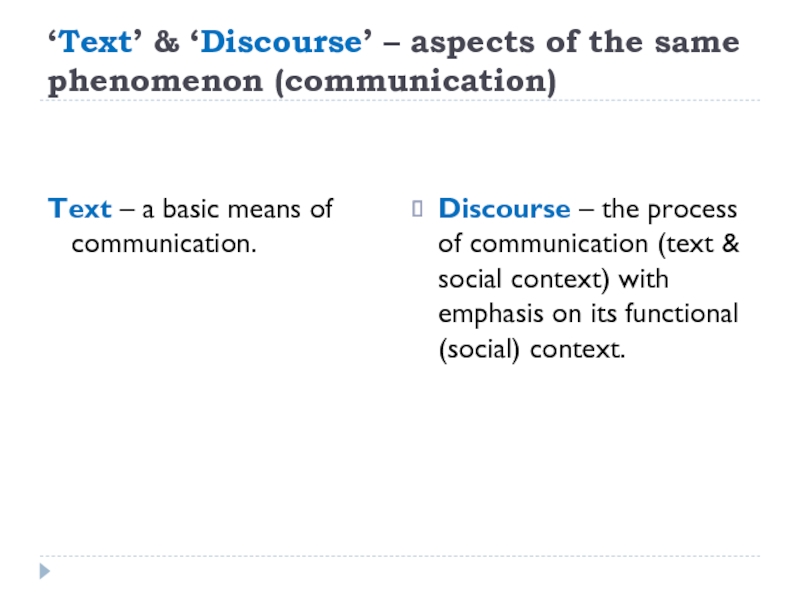
Слайд 10Morphology as a part of grammar
To study morphology — to acquire
practical knowledge of the actual functioning of morphological oppositions and how words are actually inflected in English.
Furthermore, how one is to learn to make full use of the existing morphological oppositions.
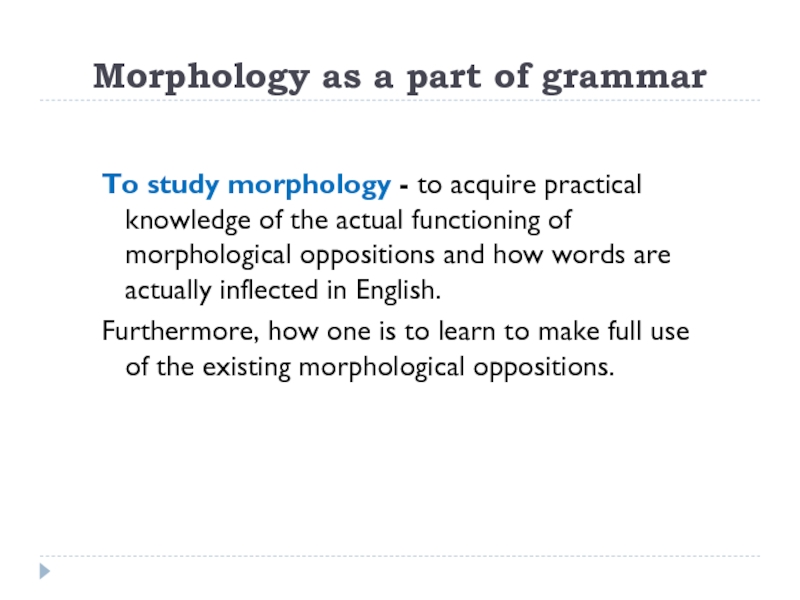
Слайд 11“Morphology” as a biological term implies a scientific study of animals
and plants
In linguistics
“morphology” — part of grammar that studies the forms of words
“accidence” — part of grammar which treats the inflection of words, or the declension of nouns, adjectives etc, and the conjugation of verbs;
it deals mainly with the inflectional or inflected word-forms.
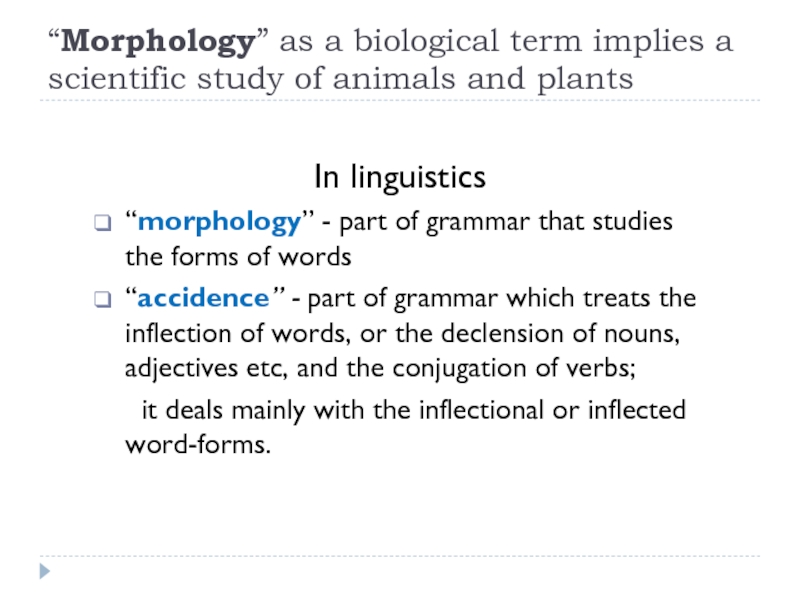
Слайд 12Since words are made up of sounds — morphology is concerned
with sequences of phonemes that have meaning.
Phonology studies speech sounds as a means of differentiating the sound-cauls of words and morphemes which are semiologically relevant,
Morphonology is aimed at analyzing the relations between phonology and morphology,
The ways the phonological oppositions are used to render morphologically: discipline — disciple, zip — sip, zeal – seal, etc.
or grammatically relevant differences (come — came, meet met, etc. ).
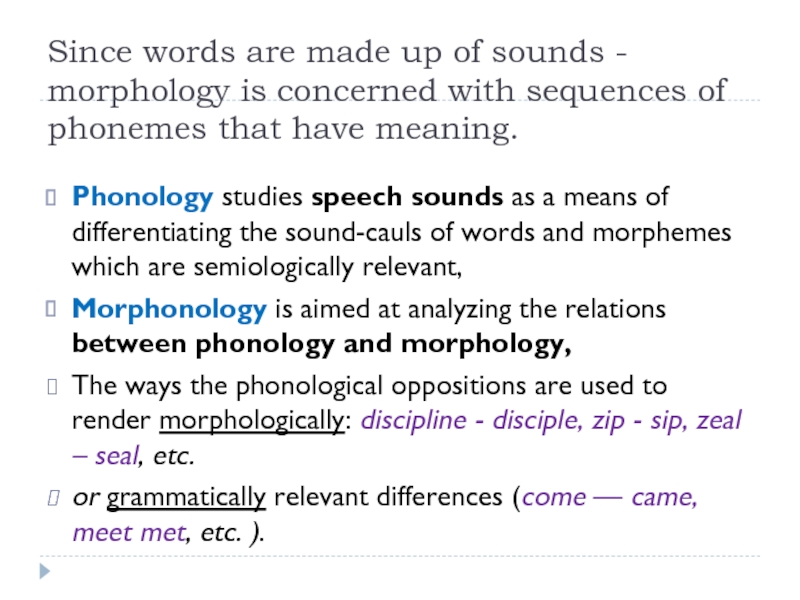
Слайд 13The word morphology
Greek morphe (=form) + logos (=word),
Element morph-:
morpheme, allomorph, or biology, theology, archeology,
Element -y recurs in history (Latin historia), unity (Old French unite), beauty (Middle English beaute = pretty).
The expression of plurality — the use of a special grammatical device — a morpheme in one of its realizations:
[s] in patients’; [z] in medical histories’, [iz] in unities of time, place and action’, [z] in nouns, names etc.
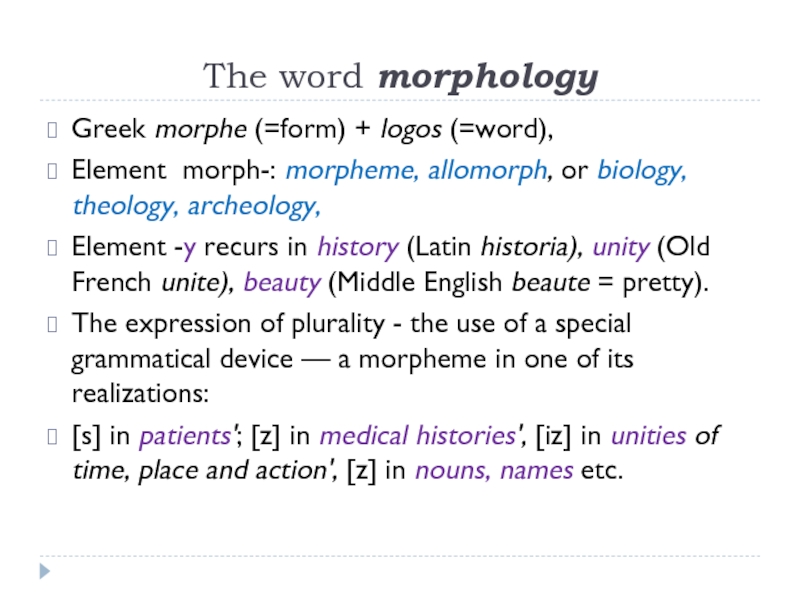
Слайд 14Morphology
that branch of linguistics which concerns itself with the structure
of words as dependent on the meaning of constituent morphemes;
the system of morphological oppositions in a given language including their grammatical categories as unities of form and content, e.g.
the word-forms speaks and worked consist of
lexical morphemes (the lexical meaning) & grammatical morphemes (the grammatical meaning of mood, tense, number, person ):
speak + s, work + ed., etc.
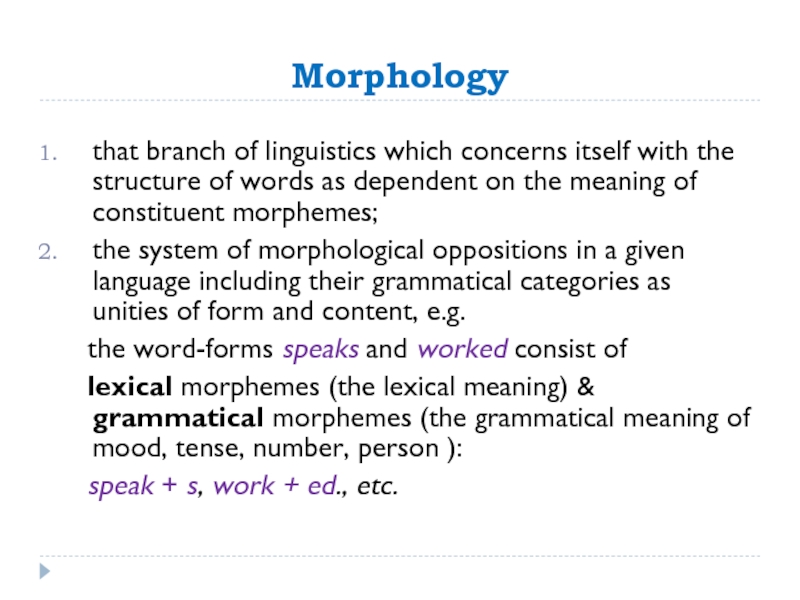
Слайд 15Morphology & Morphonology
In common: a certain unit acquires a meaning
and becomes semiologically relevant only in opposition with other units within the same system.
With phonology, morphonology and morphology: phonemes and grammatical morphemes have no individual extralinguistic referents, they become units of language only when mutually opposed:
[t] and [d] in tusk & dusk,
[-t] and [-d] in asked & cried.
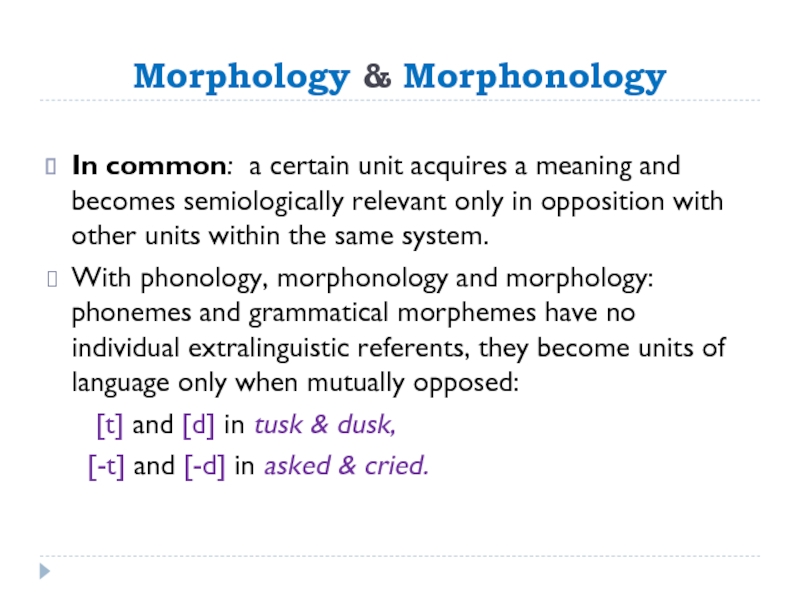
Слайд 16A morpheme –
the central notion of morphology
Morphemes — prefabs
for building words and grammatical forms of words but unlike words they are not autonomous.
I.A. Beaudoin de Courtenay:
the morpheme – the smallest meaningful part of the word.
Leonard Bloomfield:
the morpheme – the minimum linguistic form.
Joseph Vendryes:
semantemes vs. morphemes are included all the functional means of the language: word-and form-building morphemes, function words, prosodic means.
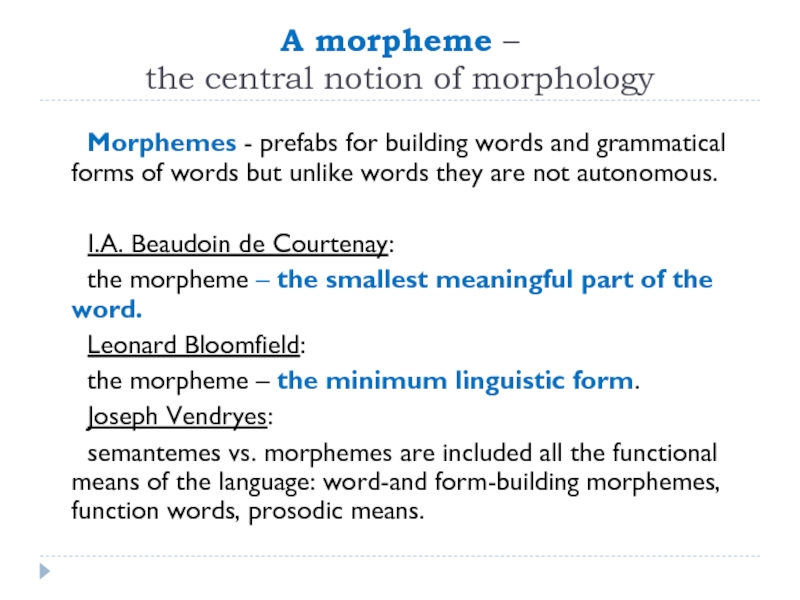
Слайд 17A word VS a morpheme
Meaning of words
Meaning of morphemes
conceptual, they
are related to concepts
very specific
more abstract and wider.
Root morphemes
have associative meaning: e.g. morpheme – friend evokes associations with many concepts: a friend, friendship, to befriend, friendly
conceptual, they are related to concepts
conceptual, they are related to concepts.
The word friend evokes in our minds the concept of a friend (which may be different in different cultures).
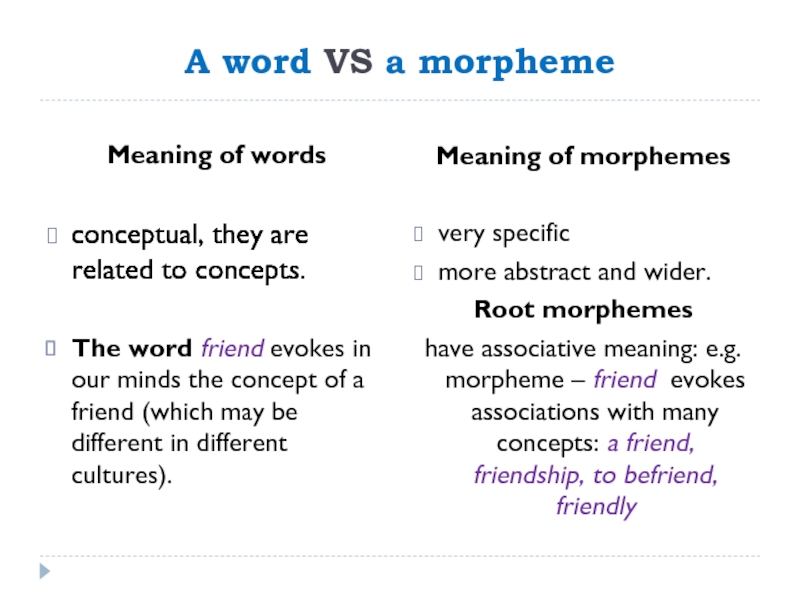
Слайд 18Discontinuous morpheme
consists of an auxiliary element and a suffixational morpheme and
which is used to build analytical forms of a word, e.g. be — ing (is doing), have — ed (have disappeared).
To conclude:
A morpheme — the smallest meaningful unit of the language (not a part of the word), which as it appears may be larger than a word in the case of analytical forms of words.
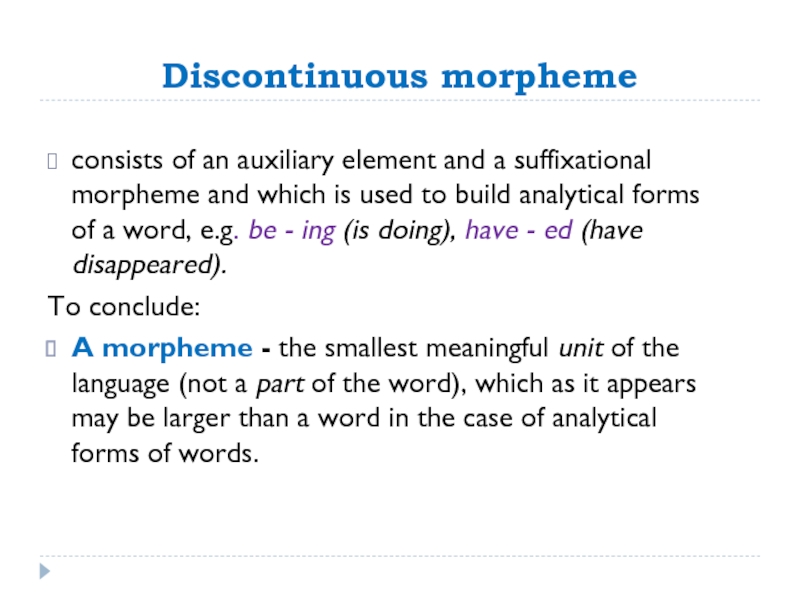
Слайд 19Classifications of morphemes
Morphemes can be classified according to several principles:
position
in the word;
function;
material form;
distribution
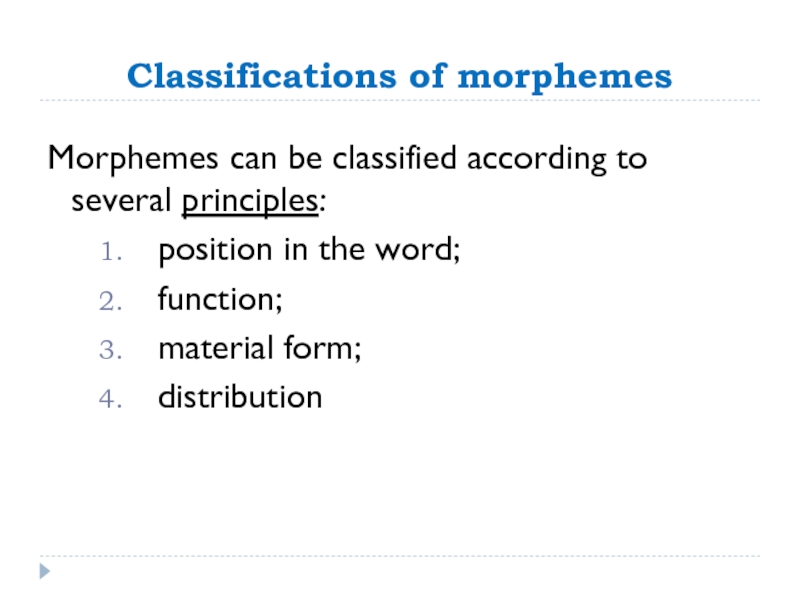
Слайд 201. According to their position in the word morphemes are subdivided
into:
central,
root morphemes:
success – ful
un – usual
re – build – ing
peripheral,
affixational morphemes:
success – ful
un – usual
re – build — ing
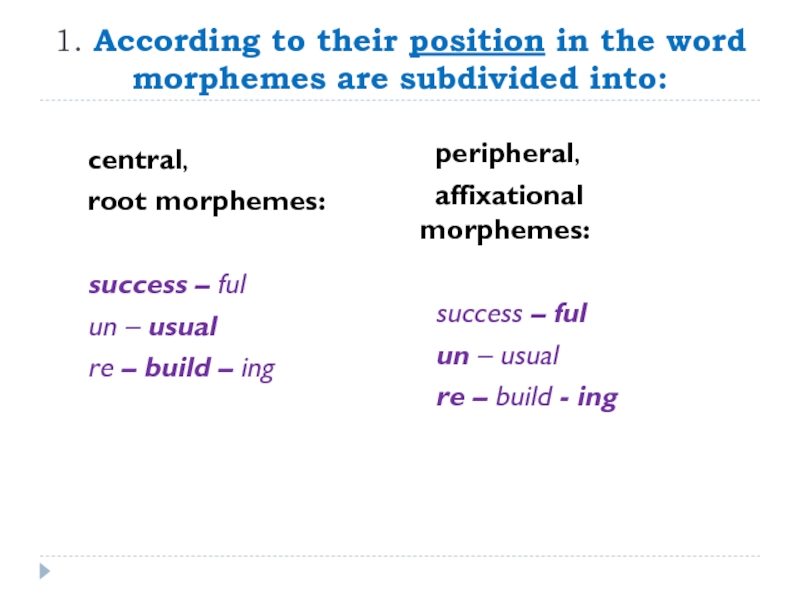
Слайд 212. According to their function morphemes fall into two classes:
Notional
morphemes
serve as carriers of the material part of the lexical meaning of a word:
post-impress-ion-ist-s
Functional morphemes
change either the lexical meaning of a word (derivational, or word-building morphemes) or the grammatical meaning (form-building, or inflectional morphemes):
post-impress-ion-ist-s
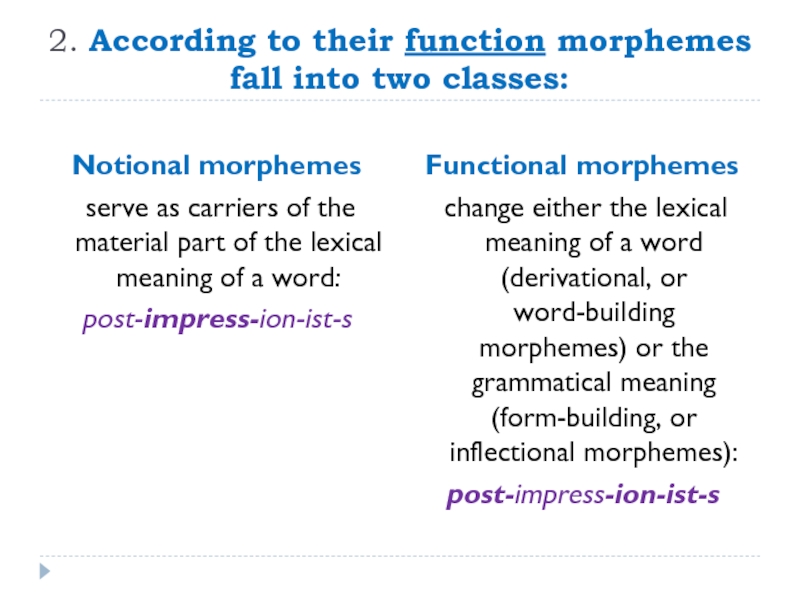
Слайд 22Notional vs. Functional morphemes
They can change their status in the course
of time.
Notional => Functional
The word-building suffixes -dom and -hood developed from root morphemes.
The function of the morpheme -man in a seaman and a policeman = derivational morpheme — or/er in sailor and officer.
The unit -man functions like a suffix in a female policeman.
Functional => Notional
The derivational suffix –teen in: a teenager, teen problems, teen tunes, teen fashion, etc.
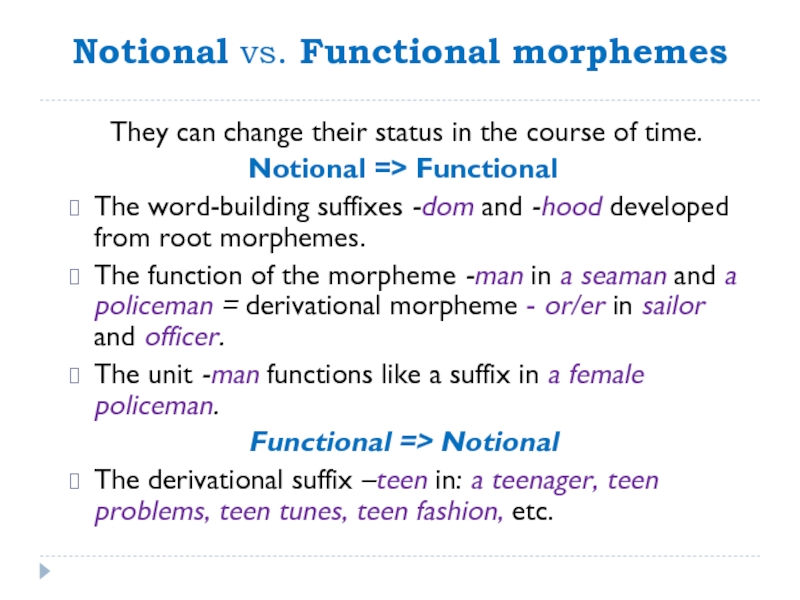
Слайд 23Occasionally suffixes are used
as notional words for expressive purposes:
E.g.
«You shouldn’t be against York, you should be against the French. Their colonialism «. «Isms andocracies. Give me facts» (G. Greene).
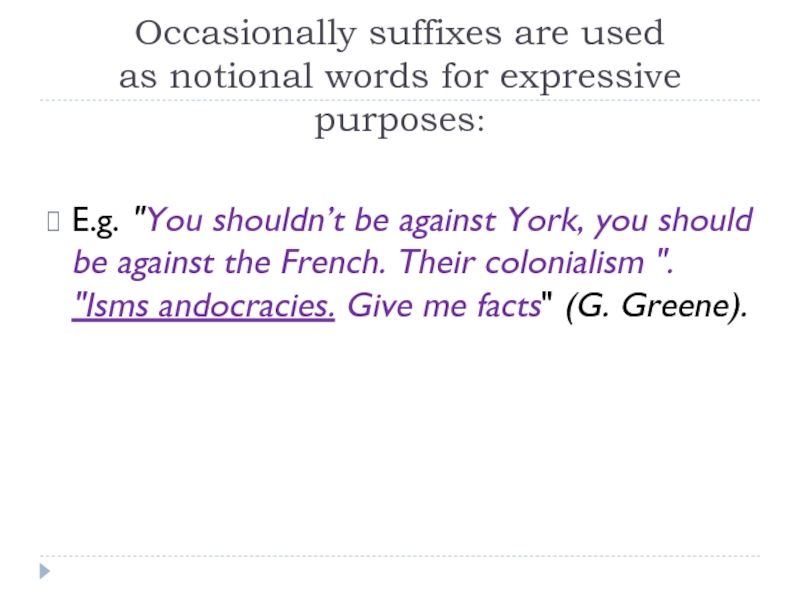
Слайд 243. According to the material form of expressing meaning morphemes can
be:
POSITIVE
ZERO
having a formal marker,
e.g. cloud — clouds
a meaningful absence of a morpheme, an absence of a formal marker which becomes obvious only in an opposition:
E.g. part(0) – part(s)
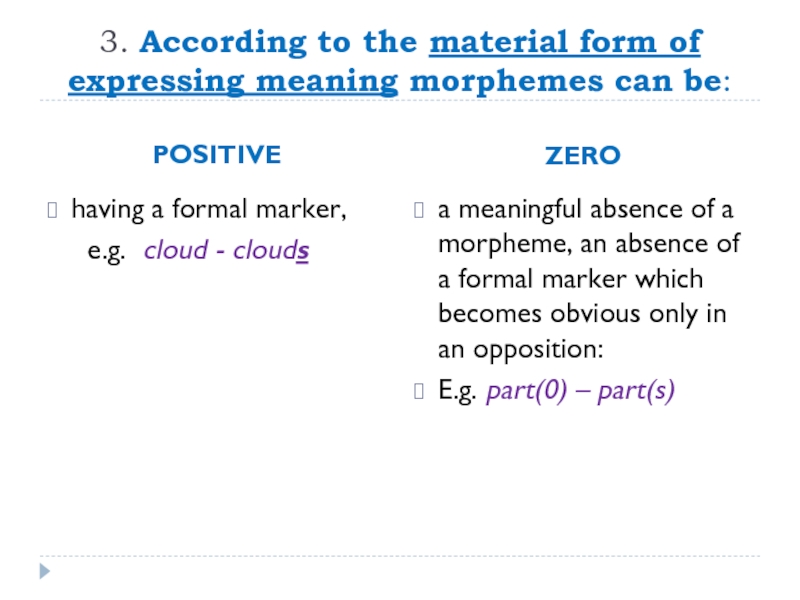
Слайд 254. According to distribution, or linear characteristics, morphemes are divided into:
Continuous
Discontinuous
is not interrupted by other elements, e.g.
map-s,
narrow-er,
un-clear…
consists of two parts: an auxiliary element and a suffix with a root morpheme in-between,
e.g. has translat-ed,
will be do-ing.
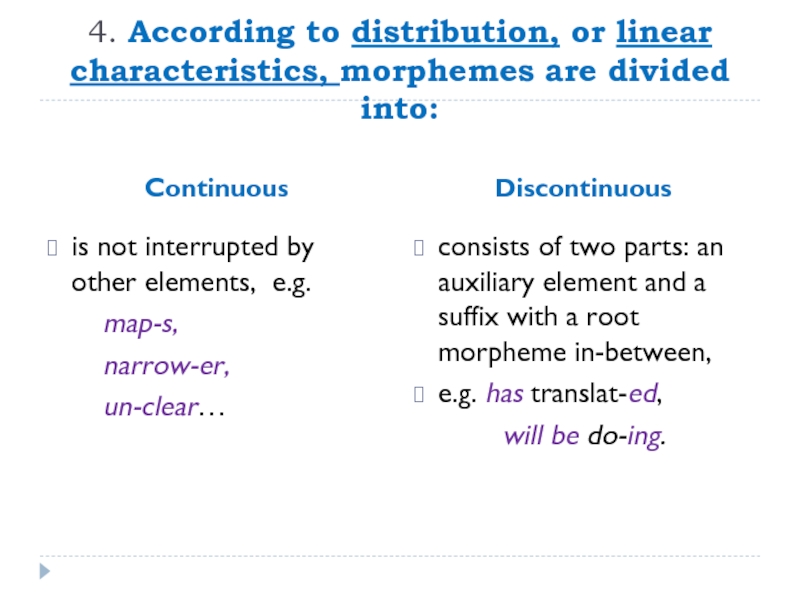
Слайд 27Words vs morphs vs morphemes vs allomorphs
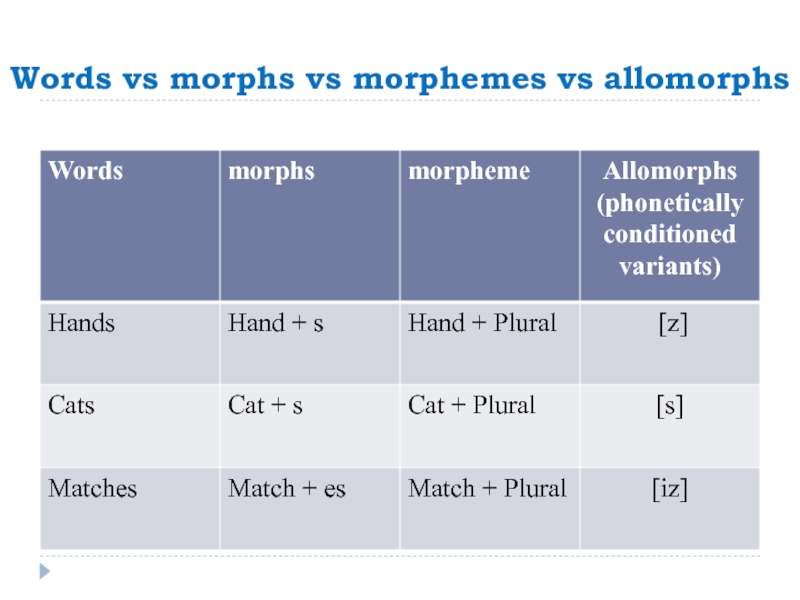
Слайд 28Words vs morphs vs morphemes vs allomorphs
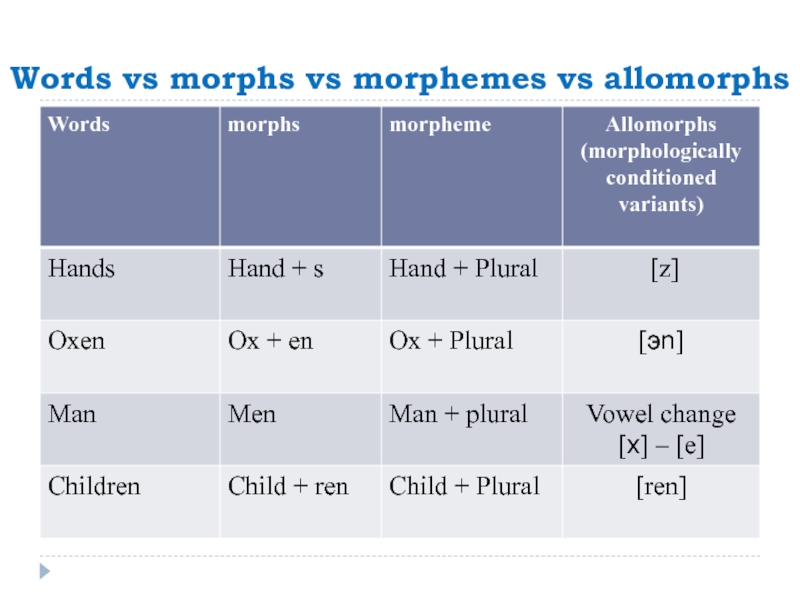
Слайд 29Morphologically conditioned allomorphs
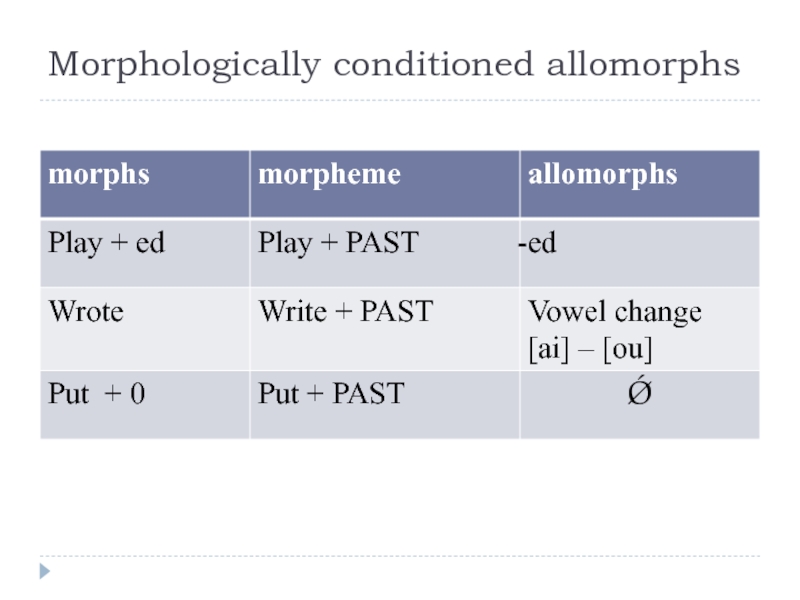
Слайд 30The morpheme is an abstraction and presents a sum of its
variants allomorphs
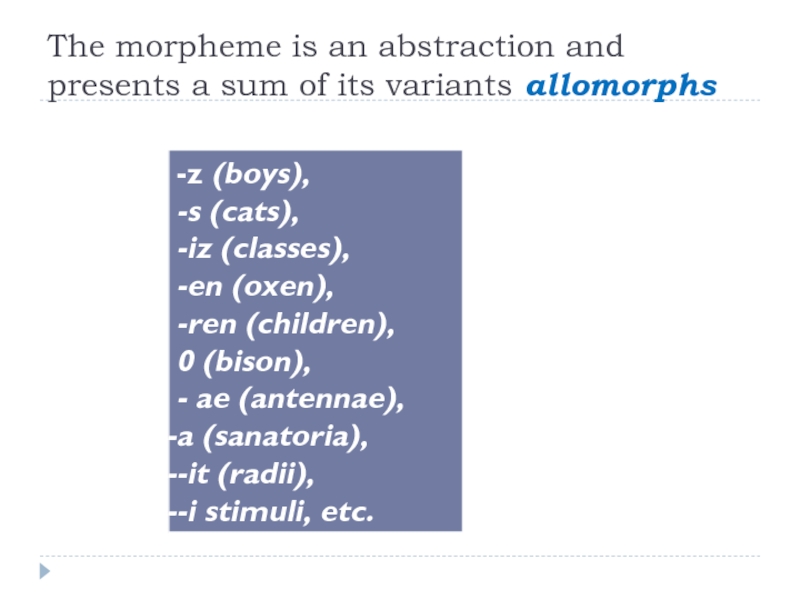
Слайд 35Group 1 (locates, locating, located):
Suffixes realize morphemes such as present, present
participle, past.
They do not change the nature of locate as a verb.
Morphemes such as present, present participle, past express grammatical meaning and are called inflectional morphemes.
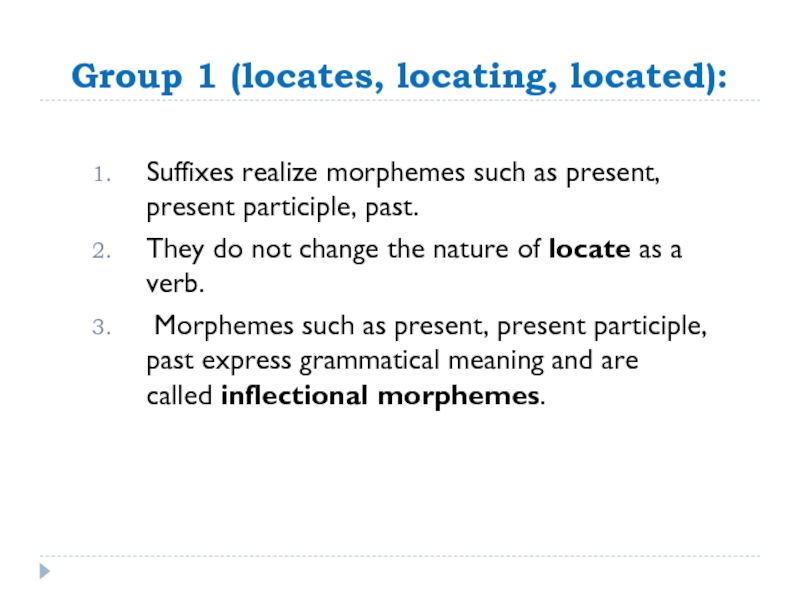
Слайд 36Inflection (inflectional morpheme):
is a major category of morphology;
has no lexical meaning
or function;
has a purely structural meaning;
has difference in grammatical meaning between these words.
The place and meaning of inflection within grammar is indisputable.
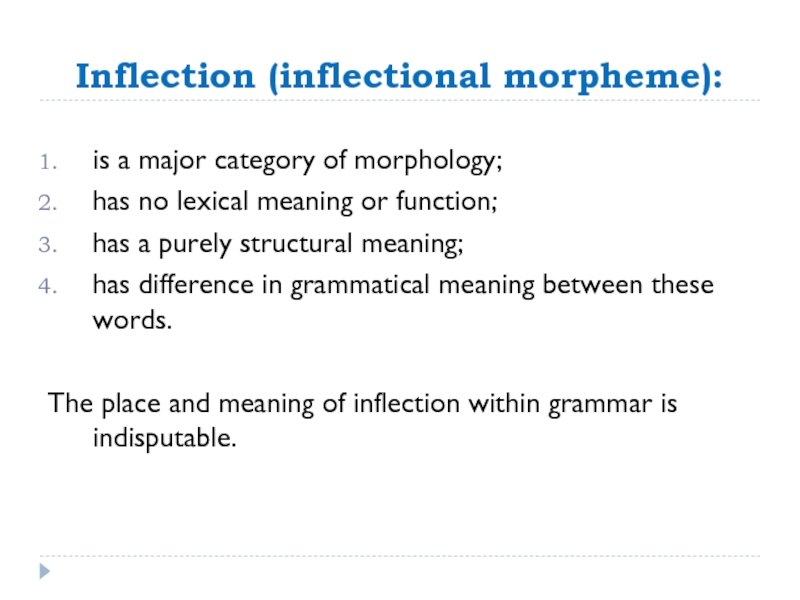
Слайд 37Group 2 (location, locative, dislocate):
add bound morphs to locate;
change its
word class;
enable us to derive new words (noun, adjective, verb with opposite lexical meaning).
Derivation — the process of adding bound morphs to form new words of the same or different word classes
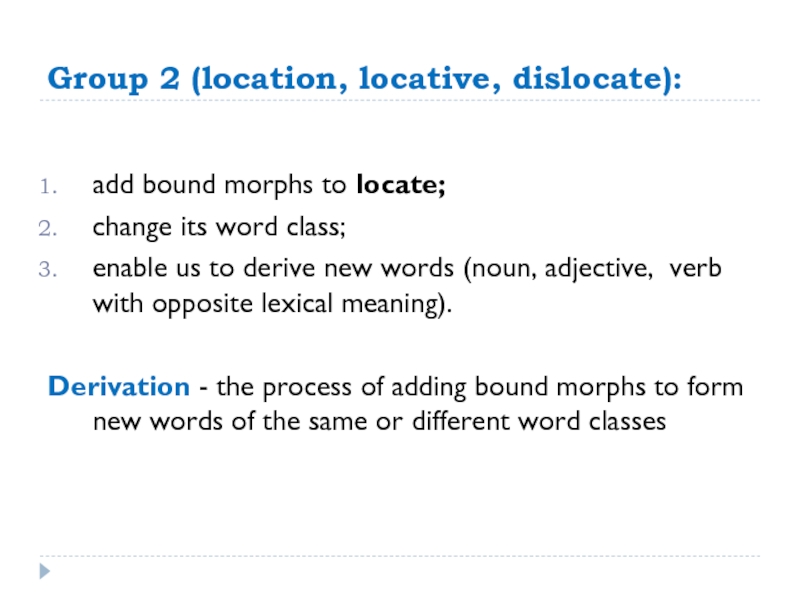
Слайд 38Group 3 (earache, workload, timebomb):
are made by combining two free
morphs — composition – combining.
The words of Groups 1 and 2 enable to form new words – word-formation (derivation & compounding)
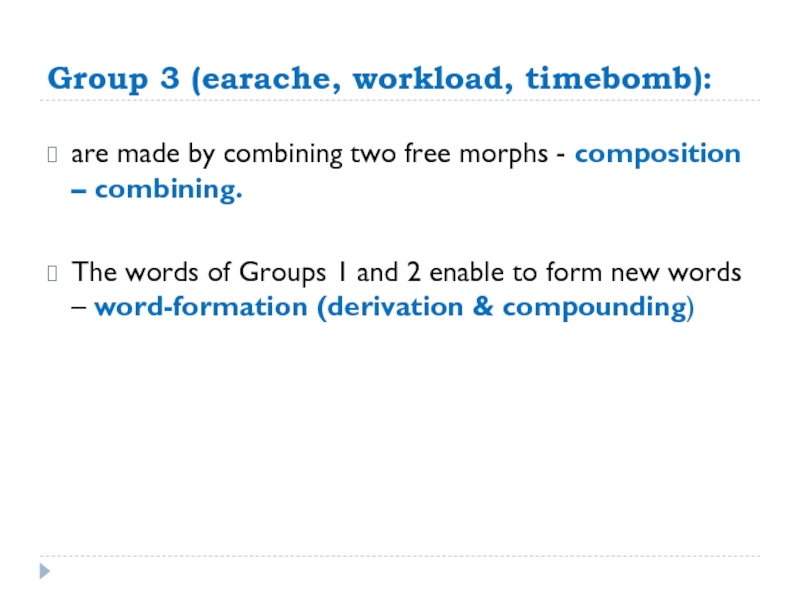
Слайд 39What is the status of word-formation?
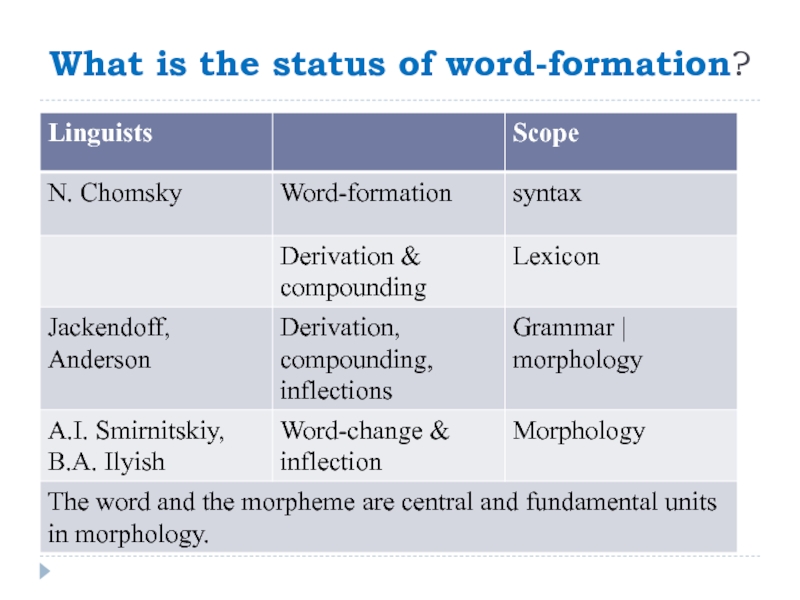
Слайд 40Inflection as a subject of morphology
Inflections are added when derivational and
compositional processes are complete.
Inflections (tense, number, person, etc.) are attached to ready-made stems, which may already have derivational affixes (repaint – repaints – repainted).
Inflectional categories (tense, voice, number) – morphosyntactic categories.
Inflectional morphemes are productive (play-s, sing-s, know-s, etc.).
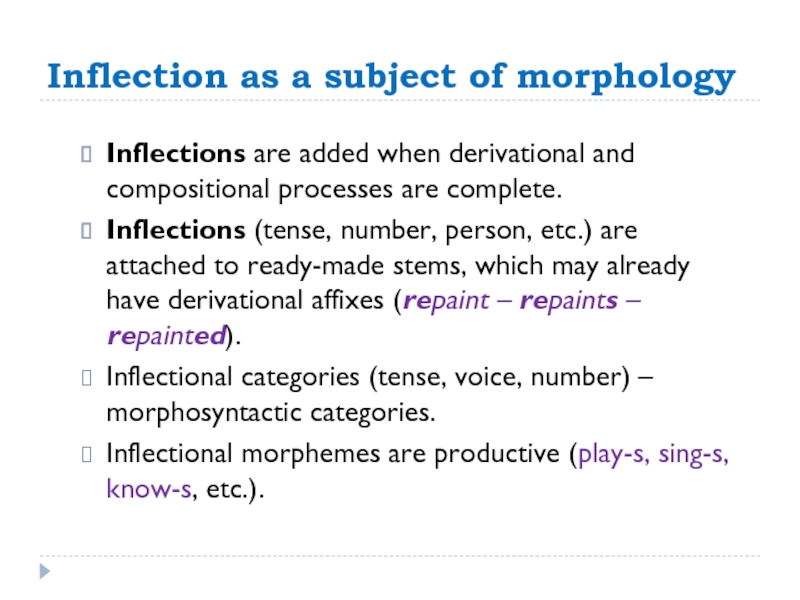
Слайд 41Types of inflections / word-change
Syntactic
Analytical
– occurring within the body of the
word (cats, cried, works, etc.).
— morphemic and vowel-change types.
– using auxiliary words (has posted, is treaded, more difficult, etc.).
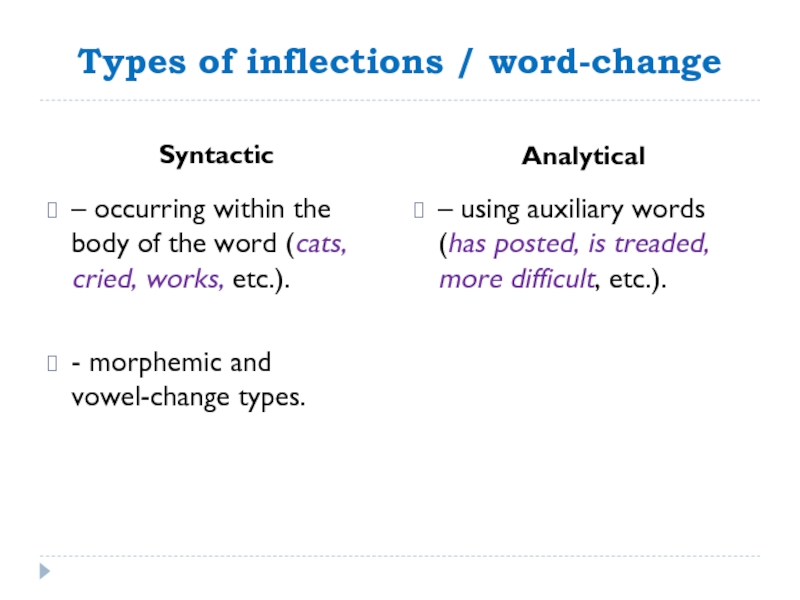
Слайд 42Morphemic types
Noun morphemes:
Verb morphemes:
Suffix –s/es forms the plural of nouns (cats,
beds, lamps, pens, etc,).
Suffixes –en / -ren (oxen, children).
Suffix –’s forms the genetic case of nouns (mother’s, Ann’s, etc.).
Suffix –s /es for the 3rd person singular PI (works, wins, watches).
Suffix –ed for the PT of regular verbs (worked, wanted, etc.).
Past Participle morphemes –suffix -d/ed (lived) & -n/en (known).
Present participle/gerund morpheme -suffix (-ing) ringing.
Adjective and adverb morphemes – suffixes –er / -est (smarter – smartest)
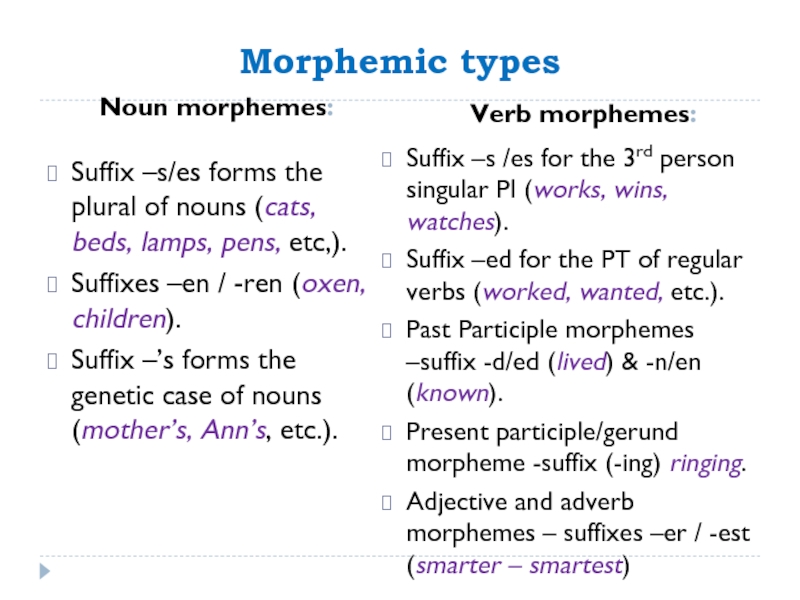
Слайд 43Vowel change / sound alternation type
Mouse – mice,
Write – wrote –
written
Take – took – taken, etc.
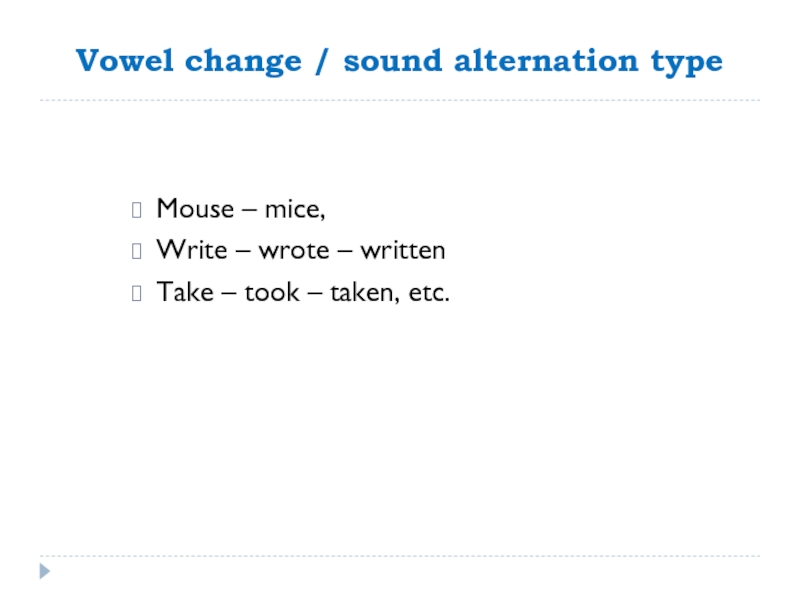
Слайд 44Analytical types
The analytical morphological form is a combination of an auxiliary
word with a basic word (have lived, is reading, was sent, will come, etc. To analytical form belong:
Perfect, Perfect Continuous, Continuous Tenses, Passive Voice, Questions, Negation, etc.
*Analytical and synthetic forms may be used together (has worked, was translated, etc. ).
Future Tenses with shall / will.
Degrees of Comparison of adjectives and adverbs with auxiliary words more & most.
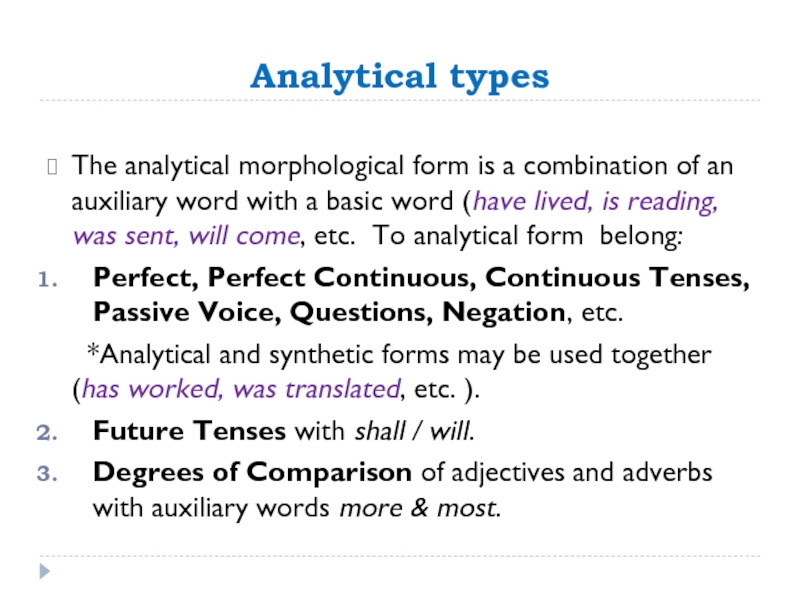
Слайд 45Suppletive formations —
Building a form of the word from an altogether
different stems:
I – me,
Be – am – are – is – was – were.
Go – went,
Good – better,
Bad – worse, etc.
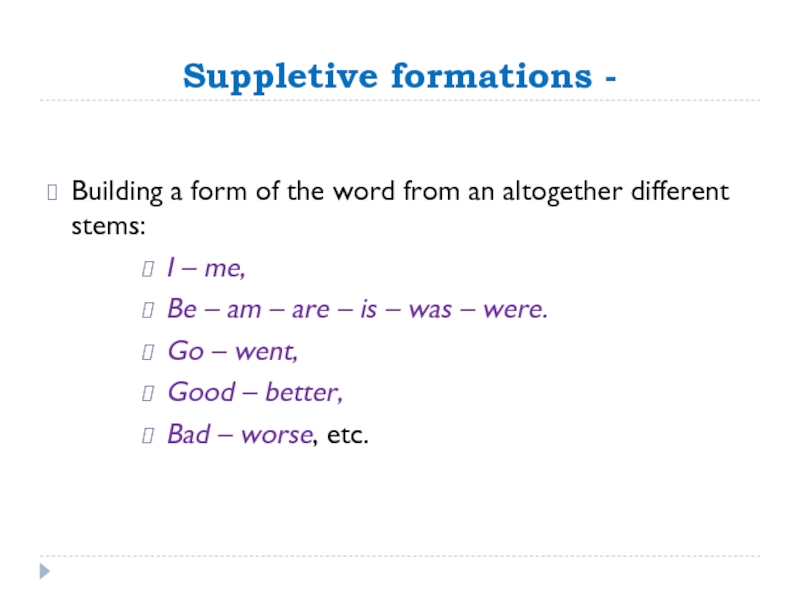






























![n retain, detain, contain or receive, conceive, perceive: sound-clusters [rı-], [dı-], [kən-] seem to n retain, detain, contain or receive, conceive, perceive: sound-clusters [rı-], [dı-], [kən-] seem to](https://present5.com/presentation/78209858_438044061/image-30.jpg)













































































